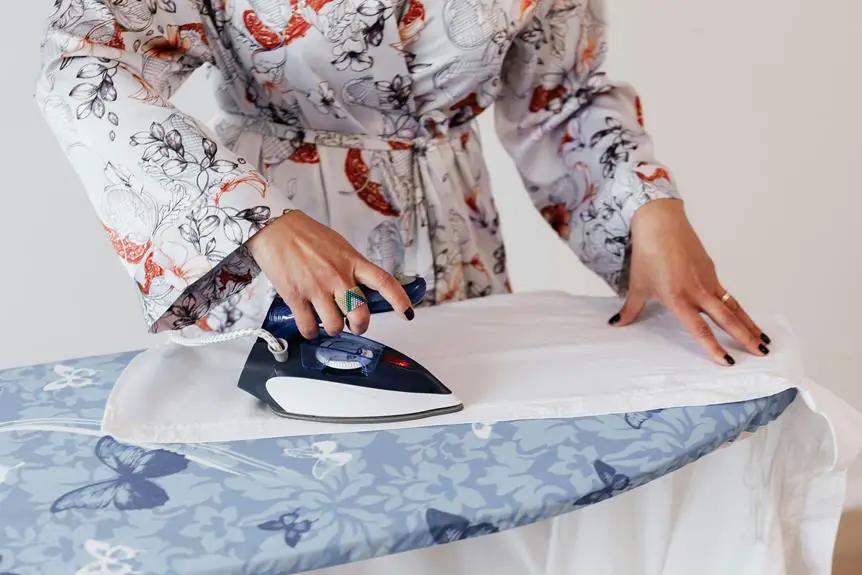When you tackle ironing pinpoint shirts, it's crucial to start with the right supplies and techniques to achieve that crisp, polished look. You'll want to gather a reliable iron, an ironing board, and a spray bottle with water. Before you set the iron to the correct temperature, it's essential to ensure your shirt is clean and slightly damp. Focusing on the collar first can make a noticeable difference, but that's just the beginning. There are specific techniques and tips that can elevate your ironing game—let's explore what you need to know next.
Table of Contents
Gather Your Supplies
Before you begin ironing your pinpoint shirts, gather all the necessary supplies to make the process smoother.
Start with a good-quality iron that's capable of reaching high temperatures. If you have a steam function, that's even better, as steam helps eliminate stubborn wrinkles.
Next, get yourself an ironing board with a padded surface. This'll give you the support you need while preventing any unwanted creases.
You'll also want a spray bottle filled with water to dampen the fabric if necessary. A pressing cloth is handy, too, especially for delicate fabrics, as it protects against direct heat.
Don't forget to have a lint roller or brush nearby to remove any lint or pet hair that might cling to your shirts.
Lastly, consider a fabric starch spray, which can give your shirts a crisp finish if that's your style.
Prepare the Shirt
To prepare the shirt for ironing, make sure it's clean and slightly damp, as this helps smooth out wrinkles more effectively. If the shirt's already dry, you can lightly mist it with water using a spray bottle. This dampness allows the fibers to relax, making it easier to achieve a crisp finish.
Next, check the shirt for any stubborn stains or spots. If you find any, treat them with a stain remover before ironing. This way, you won't accidentally set the stains with heat. After treating the stains, give the shirt a quick wash or rinse and ensure it's not too wet.
Lay the shirt flat on a clean surface or hang it on a hanger, allowing it to air-dry slightly if needed. Make sure the collar, cuffs, and placket are all aligned properly, as this will help you iron them more effectively later.
Lastly, flatten any fabric folds or creases that might've formed during storage. This preparation step can save you time and effort when you finally get to the ironing process, ensuring you achieve that polished look you desire.
Set the Iron Temperature
Once your shirt is prepped, setting the iron to the correct temperature is key for achieving the best results.
Pinpoint shirts typically consist of a cotton and polyester blend, so you'll want to find a balance that effectively removes wrinkles without damaging the fabric. Check the care label for specific guidelines; it often provides valuable insights on the optimal temperature.
For most pinpoint shirts, a medium heat setting is ideal. If your iron has a fabric setting, use the one for cotton or synthetic blends. Don't forget to let the iron preheat for a few minutes before you start ironing. This ensures the heat penetrates the fabric properly.
If you're unsure about the temperature, it's better to start lower. You can always increase the heat if needed, but you can't undo fabric damage from overheating.
Remember, steam can help with tougher wrinkles, so consider using the steam function if your iron has it.
Test a small, inconspicuous area first to make sure the temperature works well with your shirt. Once you're confident, you're ready to start ironing the shirt with precision!
Ironing Technique
Start by laying the shirt flat on the ironing board, ensuring it's smoothed out to prevent any new creases from forming.
Begin with the collar. Iron from the outer edges toward the center, using short, even strokes. This technique helps avoid puckering.
Next, move to the cuffs. Open them up and iron both sides, again starting from the edges and moving inward.
Now tackle the sleeves. Lay one sleeve flat, aligning the seams. Iron from the shoulder to the cuff, maintaining a smooth motion. Flip it over and repeat on the other side.
For the body of the shirt, work on one side at a time. Start with the front, using the same edge-to-center method. Pay extra attention to areas like the placket and pockets, as these can easily crease.
Finishing Touches
Add the finishing touches by checking for any remaining wrinkles and giving those areas a quick pass with the iron. It's the little details that make a big difference, so take a moment to inspect your shirt closely. Look for stubborn creases that may have escaped your initial ironing.
Here are three key areas to focus on:
- Collar: Ensure the collar lays flat and looks crisp. Iron both the front and back sides for a polished look.
- Cuffs: Check the cuffs for any lingering wrinkles. A well-pressed cuff can elevate your entire outfit, so give them special attention.
- Placket: The placket is the strip where the buttons and buttonholes are located. Make sure it's smooth and neat; any wrinkles here can draw unwanted attention.
Once you've given those areas some extra love, hang your shirt on a sturdy hanger to maintain its shape.
Let it cool completely before putting it away. You've done the hard work, and now your pinpoint shirt is ready to impress! Enjoy wearing it with confidence.
Frequently Asked Questions
Can I Use Steam on Pinpoint Shirts?
Yes, you can use steam on pinpoint shirts. It helps relax the fabric and removes wrinkles effectively. Just ensure you maintain a safe distance to avoid excessive moisture, which could potentially damage the fabric.
What Type of Ironing Board Is Best for Pinpoint Shirts?
For pinpoint shirts, you'll want a sturdy ironing board with a wide, padded surface. Adjustable height is essential for comfort, and a cover that reflects heat helps achieve crisp results without damaging the fabric.
How Do I Prevent Shiny Marks on Fabric?
To prevent shiny marks on fabric, use a lower heat setting and place a pressing cloth between the iron and the fabric. Also, avoid leaving the iron in one spot for too long.
Is It Safe to Iron Labels and Tags?
It's generally best to avoid ironing labels and tags, as they can melt or get damaged. If you need to press them, use a low heat setting and a cloth to protect them.
What Should I Do if the Shirt Is Wrinkled After Washing?
If your shirt's wrinkled after washing, try hanging it up immediately to air dry. You can also mist it lightly with water and gently tug the fabric to smooth out the wrinkles.
- How Does Ring Spun Cotton Affect Garment Fit and Shape Retention? - August 13, 2024
- What Are the Challenges in Producing Ring Spun Cotton? - August 13, 2024
- Is Ring Spun Cotton Suitable for Plus-Size Clothing? - August 13, 2024






